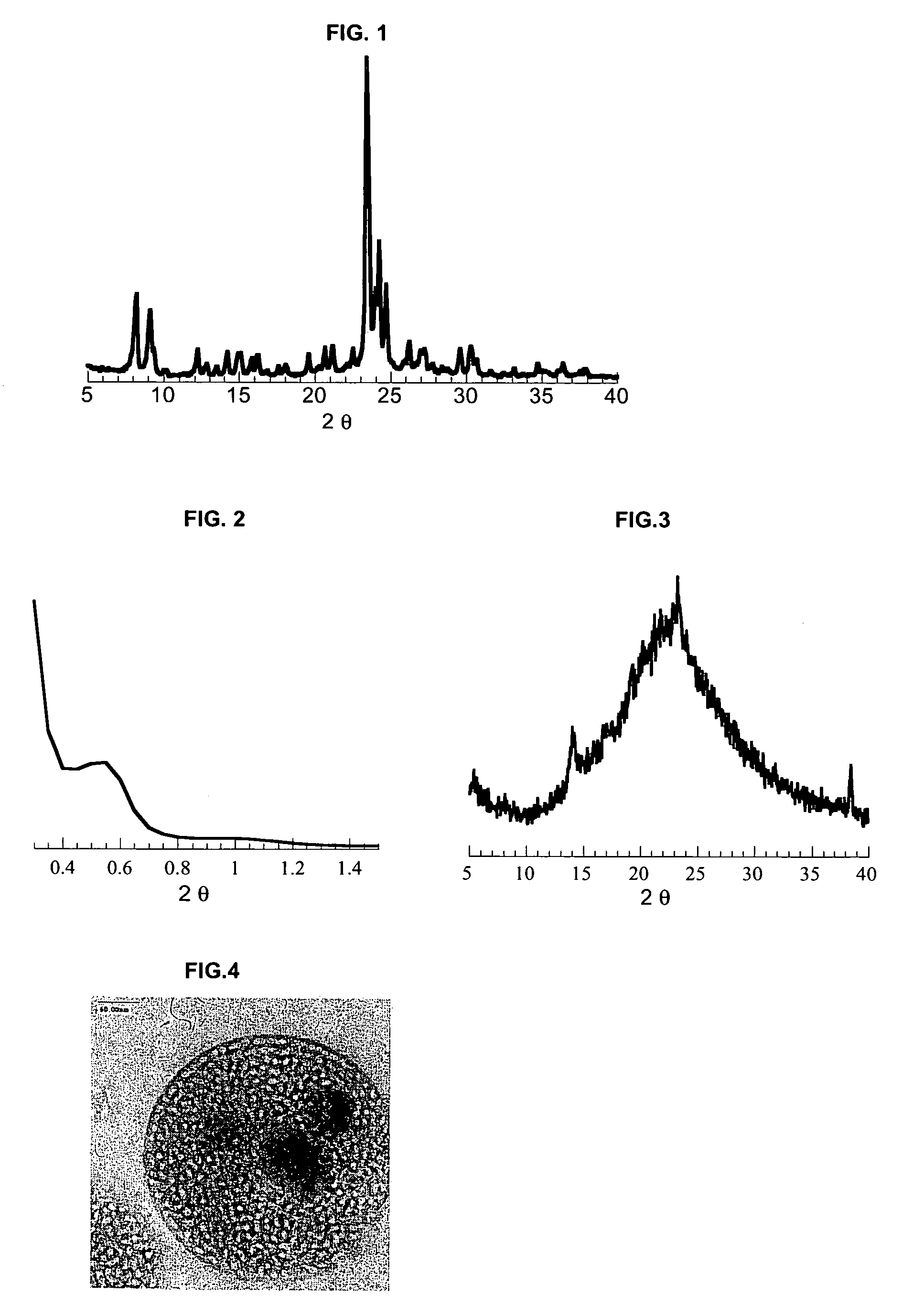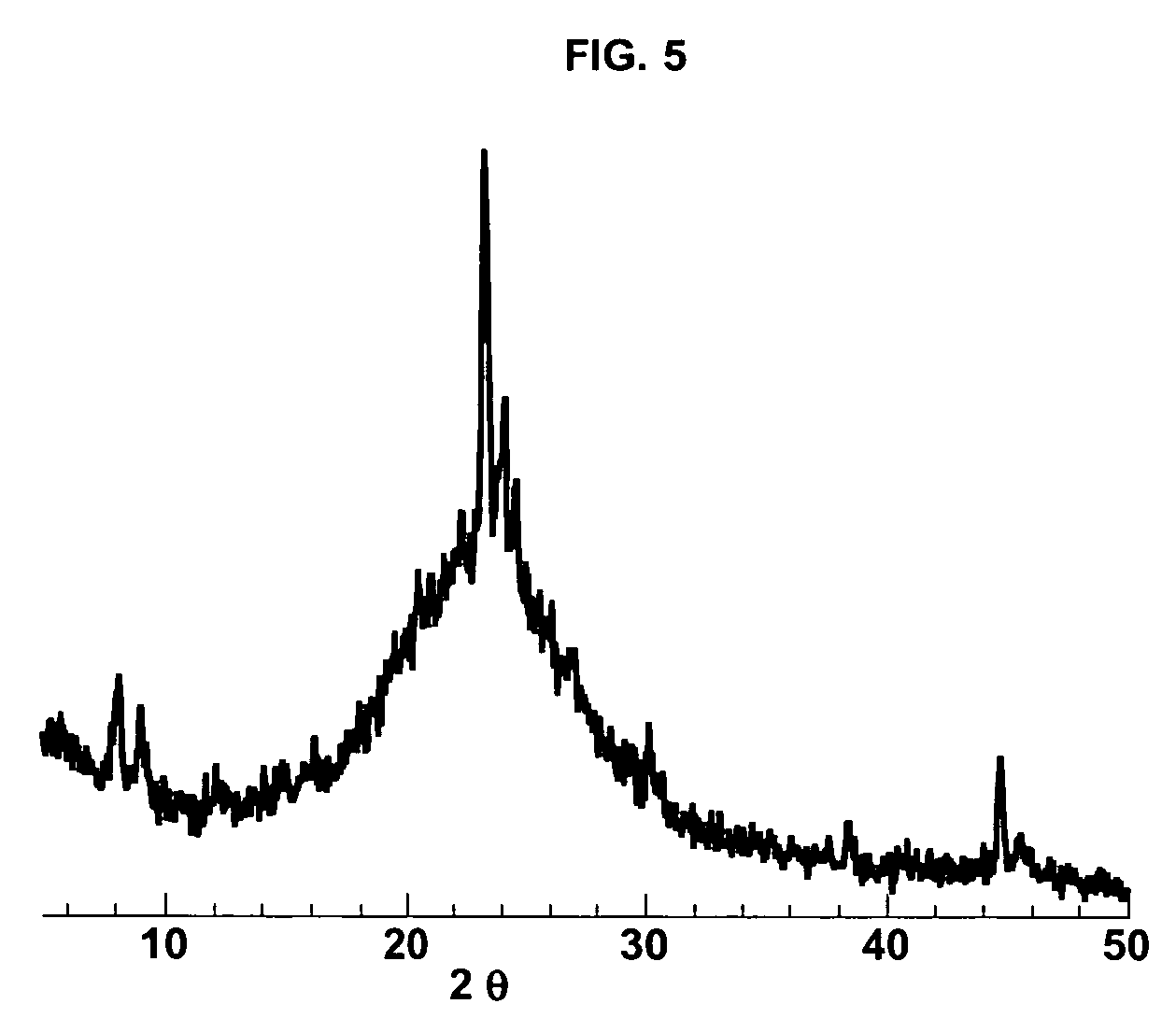Material with a hierarchical porosity comprising silicon
a technology of hierarchical porosity and silicon, applied in the direction of silicon compounds, molecular-sieve silica polymorphs, physical/chemical process catalysts, etc., can solve the problems of difficult to carry out techniques, and achieve the effect of facilitating any diffusion of reagents
- Summary
- Abstract
- Description
- Claims
- Application Information
AI Technical Summary
Benefits of technology
Problems solved by technology
Method used
Image
Examples
example 1 (
Invention)
Preparation of Material with a Hierarchical Porosity Constituted by Zeolite Nanocrystals of the Silicalite Type (MFI) in an Amount of 3.7% of the Final Material Weight and a Purely Silicic Mesostructured Matrix
[0045]6.0 g of TEOS (tetraethylorthosilicate) was hydrolyzed in 10.4 ml of tetrapropyl ammonium hydroxide (TPAOH, 20%). 1.5 ml of water was then added and the solution was stirred to obtain a clear solution. The solution was autoclaved at T=80° C. for 4 days. Once synthesis was complete, the crystals were recovered by centrifuging (20000 rpm for one hour), re-dispersed in water (ultrasound) then re-centrifuged until the solution after re-dispersion had a pH of close to 7. The pH of the colloidal suspension of silicalite-1 nanocrystals was then adjusted to 9.5 by adding a 0.1% ammoniacal solution. The mean silicalite crystal size was 100 nm. 400 μl of said solution was then added to a solution containing 30 g of ethanol, 15 ml of water, 4.5 g of TEOS, 0.036 ml of HCl ...
example 2 (
Invention)
Preparation of Material with a Hierarchical Porosity Constituted by Zeolite Nanocrystals of the ZSM-5 Type (MFI) in an Amount of 3.7% of the Final Material Weight and a Purely Silicic Mesostructured Matrix
[0046]0.14 g of aluminium sec-butoxide was added to a solution containing 7 g of tetrapropyl ammonium hydroxide solution (TPAOH, 20%), 4.3 ml of water and 0.0092 g of sodium hydroxide. 6 g of TEOS (tetraethylorthosilicate) was then added to this solution which was stirred at ambient temperature to obtain a clear solution. The solution was placed in an oven at T=95° C. for 18 hours. A milky white colloidal suspension was obtained containing ZSM-5 zeolite nanocrystals with a mean dimension of 130 nm. FIG. 1 shows a diffractogram of ZSM-5 nanocrystals. 400 μl of said solution was then added to a solution containing 30 g of ethanol, 15 ml of water, 4.5 g of TEOS, 0.036 ml of HCl and 1.4 g of F127 surfactant. The pH of the solution was adjusted to 2 with HCl. The ensemble was ...
example 3 (
Invention)
Preparation of an Aluminosilicate Material with a Hierarchical Porosity Constituted by Zeolite Nanocrystals of the ZSM-5 Type (MFI) (Si / Al=50) in an Amount of 10% of the Final Material Weight and a Aluminosilicate Mesostructured Matrix (Si / Al=4)
[0047]0.14 g of aluminium tri-sec-butoxide was added to a solution containing 3.5 ml of TPAOH, 0.01 g of sodium hydroxide NaOH and 4.3 ml of water. After dissolving the aluminium alkoxide, 6 g of TEOS (tetraethylorthosilicate) was added. The solution was stirred at ambient temperature for 5 hours and autoclaved at T=95° C. for 12 h. The white solution obtained contained 135 nm ZSM-5 nanocrystals. The solution was centrifuged at 20000 rpm for 30 minutes. The solid was redispersed in water then centrifuged again at 20000 rpm for 30 minutes. This washing was carried out twice. The nanocrystals formed a gel which was oven dried overnight at 60° C. 0.461 g of these crystals was redispersed in a solution containing 30 g of ethanol, 15 ml ...
PUM
| Property | Measurement | Unit |
|---|---|---|
| diameter | aaaaa | aaaaa |
| thickness | aaaaa | aaaaa |
| pore size | aaaaa | aaaaa |
Abstract
Description
Claims
Application Information
 Login to View More
Login to View More - R&D
- Intellectual Property
- Life Sciences
- Materials
- Tech Scout
- Unparalleled Data Quality
- Higher Quality Content
- 60% Fewer Hallucinations
Browse by: Latest US Patents, China's latest patents, Technical Efficacy Thesaurus, Application Domain, Technology Topic, Popular Technical Reports.
© 2025 PatSnap. All rights reserved.Legal|Privacy policy|Modern Slavery Act Transparency Statement|Sitemap|About US| Contact US: help@patsnap.com


